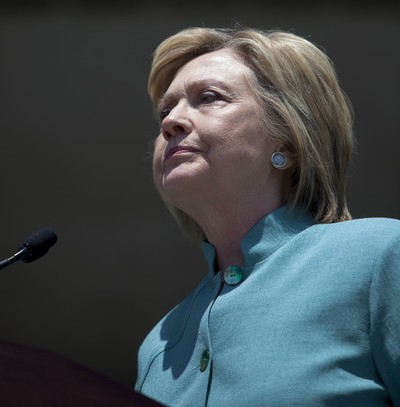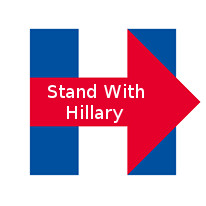HFA on Trump Foundation Funding Legal Settlements
In
response to David Fahrenthold’s latest story in the Washington Post on
Trump’s Foundation, HFA Deputy Communications Director Christina
Reynolds offered the following statement:
“Clearly the Trump
Foundation is as much a charitable organization as Trump University is
an institute of higher education. Trump’s version of charity is taking
money from others to settle his own legal issues and buy at least two
pictures of himself, which experts say is a clear violation of laws
governing charitable organizations. Once again, Trump has proven himself
a fraud who believes the rules don’t apply to him. It’s past time for
him to release his tax returns to show whether his tax issues extend to
his own personal finances.”
IN CASE YOU MISSED IT
Trump used $258,000 from his charity to settle legal problems
Washington Post
By David A. Fahrenthold
September 20, 2016
Donald
Trump spent more than a quarter-million dollars from his charitable
foundation to settle lawsuits that involved the billionaire’s for-profit
businesses, according to interviews and a review of legal documents.
Those
cases, which together used $258,000 from Trump’s charity, were among
four newly documented expenditures in which Trump may have violated laws
against “self-dealing” — which prohibit nonprofit leaders from using
charity money to benefit themselves or their businesses.
In one
case, from 2007, Trump’s Mar-a-Lago Club faced $120,000 in unpaid fines
from the town of Palm Beach, Fla., resulting from a dispute over the
size of a flagpole.
In a settlement, Palm Beach agreed to waive
those fines — if Trump’s club made a $100,000 donation to a specific
charity for veterans. Instead, Trump sent a check from the Donald J.
Trump Foundation, a charity funded almost entirely by other people’s
money, according to tax records.
The check to charity from the Trump Foundation.
In
another case, court papers say one of Trump’s golf courses in New York
agreed to settle a lawsuit by making a donation to the plaintiff’s
chosen charity. A $158,000 donation was made by the Trump Foundation,
according to tax records.
The other expenditures involved smaller
amounts. In 2013, Trump used $5,000 from the foundation to buy
advertisements touting his chain of hotels in programs for three events
organized by a D.C. preservation group. And in 2014, Trump spent $10,000
of the foundation’s money for a portrait of himself bought at a charity
fundraiser.
Or, rather, another portrait of himself.
Several years earlier, Trump had used $20,000 from the Trump Foundation to buy a different, six foot-tall portrait.
If
the Internal Revenue Service were to find that Trump violated
self-dealing rules, the agency could require him to pay penalty taxes or
to reimburse the foundation for all the money it spent on his behalf.
Trump is also facing scrutiny from the office of the New York attorney
general, which is examining whether the foundation broke state charity
laws.
More broadly, these cases also provide new evidence that
Trump ran his charity in a way that may have violated U.S. tax law and
gone against the moral conventions of philanthropy.
“I represent 700 nonprofits a year, and I’ve never encountered anything so brazen,” said Jeffrey Tenenbaum,
who advises charities at the Venable law firm in Washington. After The
Post described the details of these Trump Foundation gifts, Tenenbaum
described them as “really shocking.”
“If he’s using other people’s
money — run through his foundation — to satisfy his personal
obligations, then that’s about as blatant an example of self-dealing
[as] I’ve seen in a while,” Tenenbaum said.
The Post sent the Trump campaign a detailed list of questions about the four cases, but received no response.
The
New York attorney general’s office declined to comment when asked
whether its inquiry would cover these new cases of possible
self-dealing.
Trump founded his charity in 1987 and, for years,
was its only donor. But in 2006, Trump gave away almost all of the money
he had donated to the foundation, leaving it with just $4,238 at year’s
end, according to tax records.
Then, he transformed the Trump
Foundation into something rarely seen in the world of philanthropy: a
name-branded foundation, whose namesake provides none of its money.
Trump gave relatively small donations in 2007 and 2008, and afterward:
nothing. The foundation’s tax records show no donations from Trump since
2009.
Its money has come from other donors, most notably
pro-wrestling executives Vince and Linda McMahon, who gave a total of $5
million from 2007 to 2009, tax records show. Trump remains the
foundation’s president, and he told the IRS in his latest public filings
that he works half an hour per week on the charity.
The Post has previously detailed other cases in which Trump used the charity’s money in a way that appeared to violate the law.
In
2013, for instance, the foundation gave $25,000 to a political group
supporting Florida Attorney General Pam Bondi (R). That gift was made
around the same time that Bondi’s office was considering whether to
investigate fraud allegations against Trump University. It didn’t.
Tax
laws say nonprofits such as the Trump Foundation may not make political
gifts. Trump staffers blamed the gift on a clerical error. After The
Post reported on the gift to Bondi’s group this spring, Trump paid a $2,500 penalty tax and reimbursed the Trump Foundation for the $25,000 donation.
In other instances, it appeared that Trump may have violated rules against self-dealing.
In 2012, for instance, Trump spent $12,000 of the foundation’s money to buy a football helmet signed by NFL quarterback Tim Tebow.
And
in 2007, Trump’s wife, Melania, bid $20,000 for the six-foot-tall
portrait of Trump, done by a “speed painter” during a charity gala at
Mar-a-Lago. Later, Trump paid for the painting with $20,000 from the foundation.
In
those cases, tax experts said, Trump was not allowed to simply keep
these items and display them in a home or business. They had to be put
to a charitable use.
Trump’s campaign has not responded to questions about what became of the helmet or the portrait.
The
four new cases of possible self-dealing were discovered in the Trump
Foundation’s tax filings. While Trump has refused to release his
personal tax returns, the foundation’s filings are required to be
public.
The case involving the flagpole at Trump’s oceanfront
Mar-a-Lago Club began in 2006, when the club put up a giant American
flag on the 80-foot pole. Town rules said flagpoles should be 42 feet
high at most. Trump’s contention, according to news reports, was: “You
don’t need a permit to put up the American flag.”
The town began to fine Trump, $1,250 a day.
Trump’s
club sued in federal court, saying that a smaller flag “would fail to
appropriately express the magnitude of Donald J. Trump’s . . .
patriotism.”
They settled.
The town waived the $120,000 in fines. In September 2007, Trump wrote the town a letter, saying he had done his part as well.
“I
have sent a check for $100,000 to Fisher House,” he wrote. The town had
chosen Fisher House, which runs a network of comfort homes for the
families of veterans and military personnel receiving medical treatment,
as the recipient of the money. Trump added that, for good measure, “I
have sent a check for $25,000” to another charity, the American Veterans
Disabled for Life Memorial.
Trump provided the town with copies of the checks, which show that they came from the Trump Foundation.
In
the town of Palm Beach, nobody seems to have objected that the fines
assessed on Trump’s business were being erased by a donation from a
charity.
“I don’t know that there was any attention paid to that
at the time. We just saw two checks signed by Donald J. Trump,” said
John Randolph, the Palm Beach town attorney. “I’m sure we were satisfied
with it.”
Excerpt from a settlement filed in federal court in 2007.
In
the other case in which a Trump Foundation payment seemed to help
settle a legal dispute, the trouble began with a hole-in-one.
In
2010, a man named Martin Greenberg hit a hole-in-one on the 13th hole
while playing in a charity tournament at Trump’s course in Westchester
County, N.Y.
Greenberg won a $1 million prize. Briefly.
Later,
Greenberg was told that he had won nothing. The prize’s rules required
that the shot had to go 150 yards. But Trump’s course had allegedly made
the hole too short.
Greenberg sued.
Eventually, court
papers show, Trump’s golf course signed off on a settlement that
required it to make a donation of Martin Greenberg’s choosing. Then, on
the day that the parties informed the court they had settled their case,
a $158,000 donation was sent to the Martin Greenberg Foundation.
That money came from the Trump Foundation, according to the tax filings of both Trump’s and Greenberg’s foundations.
Greenberg’s foundation reported getting nothing that year from Trump personally or from his golf club.
Both Greenberg and Trump have declined to comment.
Several tax experts said that the two cases appeared to be clear cases of self-dealing, as defined by the tax code.
The Trump Foundation had made a donation, it seemed, so that a Trump business did not have to.
Rosemary E. Fei, a lawyer in San Francisco who advises nonprofits, said both cases clearly fit the definition of self-dealing.
“Yes,
Trump pledged as part of the settlement to make a payment to a charity,
and yes, the foundation is writing a check to a charity,” Fei said.
“But the obligation was Trump’s. And you can’t have charitable
foundation paying off Trump’s personal obligations. That would be
classic self-dealing.” In another instance, from 2013, the Trump
Foundation made a $5,000 donation to the D.C. Preservation League,
according to the group and tax filings. That nonprofit’s support has
been helpful for Trump as he has turned the historic Old Post Office
Pavilion on Washington’s Pennsylvania Avenue NW into a luxury hotel.
The
Trump Foundation’s donation to that group bought a “sponsorship,” which
included advertising space in the programs for three big events that
drew Washington’s real estate elite. The ads did not mention the
foundation or anything related to charity. Instead, they promoted
Trump’s hotels, with glamorous photos and a phone number to call to make
a reservation.
“The foundation wrote a check that essentially
bought advertising for Trump hotels?” asked John Edie, the longtime
general counsel for the Council on Foundations, when a Post reporter
described this arrangement. “That’s not charity.”
The last of the four newly documented expenditures involves the second painting of Trump, which he bought with charity money.
It
happened in 2014, during a gala at Mar-a-Lago that raised money for
Unicorn Children’s Foundation — a Florida charity that helps children
with developmental and learning disorders.
The gala’s main event was a concert by Jon Secada. But there was also an auction of paintings by Havi Schanz, a Miami Beach-based artist.
One
was of Marilyn Monroe. The other was a four foot-tall portrait of
Trump: a younger-looking, mid-’90s Trump, painted in acrylic on top of
an old architectural drawing.
Trump bought it for $10,000.
Afterward,
Schanz recalled in an email, “he asked me about the painting. I said,
‘I paint souls, and when I had to paint you, I asked your soul to allow
me.’ He was touched and smiled.”
A few days later, the charity
said, a check came from the Trump Foundation. Trump himself gave
nothing, according to Sharon Alexander, the executive director of the
charity.
Trump’s staff did not respond to questions about where
that second painting is now. Alexander said she had last seen it at
Trump’s club.
“I’m pretty sure we just left it at Mar-a-Lago,” she said, “and his staff took care of it.”




